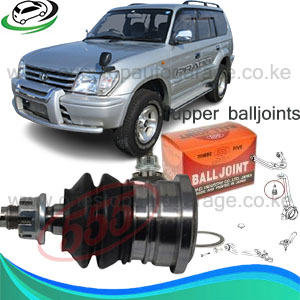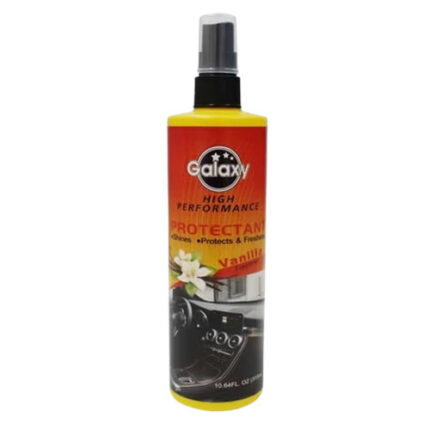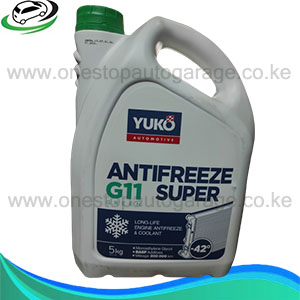-14%
Get Yuko Antifreeze Super Coolant G11 Green 5litres
Antifreeze, often referred to as engine coolant or radiator coolant, is a vital fluid used in automotive engines to regulate temperature and prevent overheating. Here’s a detailed explanation of what antifreeze super coolant typically offers and its importance in vehicle maintenance:
Function and Importance of Antifreeze Super Coolant:
- Heat Transfer and Temperature Regulation:
- Antifreeze circulates through the engine and absorbs excess heat generated during combustion.
- It transfers this heat to the radiator, where it is dissipated into the surrounding air to prevent engine overheating.
- Freeze and Boil Protection:
- Antifreeze is designed to lower the freezing point of water, preventing coolant from freezing in cold temperatures.
- It also raises the boiling point of water, allowing the engine to operate at higher temperatures without coolant boiling over.
- Corrosion Prevention:
- Antifreeze contains additives that inhibit corrosion and rust formation within the engine and cooling system.
- This helps prolong the life of engine components and maintains the efficiency of heat transfer.
- Lubrication and Seal Protection:
- Some antifreeze formulations include lubricating agents that help extend the life of water pump seals and other components.
- Proper lubrication reduces wear and tear on moving parts within the cooling system.
- Compatibility with Materials:
- Antifreeze is formulated to be compatible with various metals and materials used in engine construction, such as aluminum, copper, and steel.
- It prevents galvanic corrosion that can occur when dissimilar metals are in contact with each other in the presence of coolant.
Types of Antifreeze Coolants:
- Ethylene Glycol: Traditional antifreeze coolant widely used in most vehicles due to its effective heat transfer properties and affordability.
- Propylene Glycol: Non-toxic alternative to ethylene glycol, used in some environmentally sensitive applications and certain newer vehicles.
- Long-Life Formulations: Extended-life coolants (ELC) or organic acid technology (OAT) coolants, which offer longer service intervals and enhanced corrosion protection.
Signs of Issues with Antifreeze Super Coolant:
-
1. Coolant Leaks:
- Puddles Under the Vehicle: Visible coolant puddles or spots under your parked vehicle are a clear indicator of a coolant leak.
- Corrosion or Wetness: Look for signs of corrosion or wetness around radiator hoses, connections, water pump, and radiator itself.
2. Overheating Engine:
- High Temperature Gauge: If your engine temperature gauge consistently shows higher-than-normal readings, it could indicate insufficient coolant circulation due to low coolant levels or a coolant leak.
- Steam or Vapor: Visible steam or vapor coming from under the hood, especially after the engine has warmed up, suggests overheating.
3. Low Coolant Levels:
- Coolant Reservoir: Check the coolant reservoir regularly to ensure it is filled to the proper level indicated by the markings.
- Frequent Refills: If you find yourself needing to refill the coolant reservoir often, it may indicate a leak or excessive coolant consumption.
4. Discolored Coolant:
- Color Change: Healthy coolant is typically brightly colored (green, orange, pink, blue, etc., depending on the type).
- Rust or Sediment: Discoloration, cloudiness, or the presence of rust particles in the coolant may indicate contamination or chemical breakdown, requiring coolant flush and replacement.
5. Foaming or Bubbling in Radiator:
- Air Pocket: Foaming or bubbling in the radiator when the engine is running suggests air pockets in the cooling system.
- Combustion Gas Entry: Continuous bubbling may indicate combustion gases entering the cooling system, often due to a blown head gasket or other internal engine issues.
6. Sweet Smell or Odor:
- Distinctive Odor: A sweet smell inside or outside the vehicle, especially near the engine or radiator, is a characteristic sign of coolant leakage.
- Cabin Smell: If you notice this smell inside the cabin, it could mean a leak in the heater core, which uses engine coolant to heat the cabin air.
7. Corrosion and Buildup:
- Visible Corrosion: Check for signs of corrosion on radiator fins, hoses, connections, and around the coolant reservoir.
- Mineral Deposits: White or greenish mineral deposits around radiator cap or openings can indicate coolant leak and evaporation.
8. Heater Malfunction:
- No Heat: If your vehicle’s heater doesn’t produce hot air or takes longer than usual to warm up, it may indicate low coolant levels or circulation issues.
9. Coolant Warning Light:
- Dashboard Indicator: Many vehicles have a coolant warning light that illuminates when coolant levels are low or when the engine temperature is too high.
- Check Engine Light: In some cases, engine overheating due to coolant issues can trigger the check engine light.
Maintenance and Replacement:
- Regular Inspection: Check coolant levels regularly and inspect for signs of leaks, discoloration, or contamination.
- Flush and Replace: Follow manufacturer recommendations for coolant flush intervals (typically every 2-5 years) and use the recommended coolant type.
- Professional Service: If unsure or experiencing issues with the cooling system, consult a qualified mechanic for diagnosis and repair.
Follow us on Facebook For more parts.



